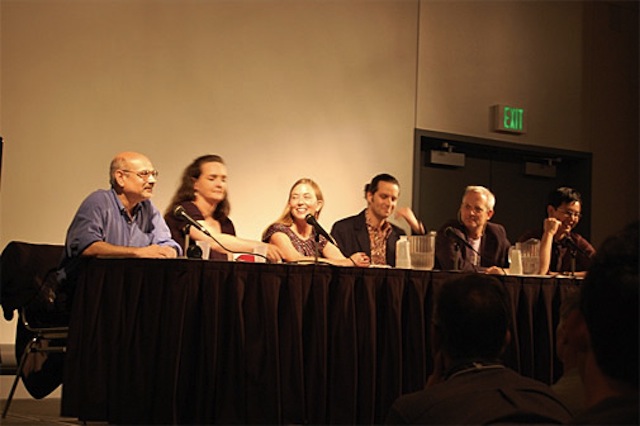Graphic designer William Drenttel died on Saturday, a multifaceted creative who played many roles: a em>Mad Men-era ad man, a design industry legend, an advocate for social change. But as the founder of Design Observer, the influential design blog launched 10 years ago, Bill irrevocably transformed the way we talk about design.
For much of his 40-year career, Bill ran the design firm Winterhouse, with his wife and partner Jessica Helfand, which was housed in a bucolic modern home in rural Connecticut. (Before that, Bill headed the firm Drenttel Doyle Partners and the character David Clennon played on thirtysomething was inspired by and named after him. No joke.) Writing was always central to their practice, from clients like The New Yorker to publishing their own journals. But they sensed an emerging need to fix something lacking in design culture — a better way for designers to discuss and disseminate the issues of the day.
When Bill launched Design Observer in 2003 with Jessica, designer Michael Bierut, and critic Rick Poynor, I was a fledgling design writer hungry for new ideas. Design Observer was something irrefutably new: A design publication that could find the “design” in anything, from small town community meetings to Stanley Kubrick films, moving between academic-quality journal and pop culture commentary with incredible deftness. I voraciously studied the site and stalked its writers — they always managed to publish the big names — as I launched my own career. Bill became a friend, collaborator, and champion of so many designers and writers, including myself.
Drenttel and Helfand were awarded the AIGA Medal in 2013
Bill had a keen journalistic instinct, and much of the tone and content of the publication was thanks to his own editorial prowess. It was Bill, for example, who intuited the industry-wide focus on socially focused design and launched the site’s Change Observer initiative, winning a Rockefeller Foundation grant to focus on stories about social impact and allowing Design Observer to play a role in amplifying and implementing game-changing ideas for society.
Design Observer quite literally changed the way we as a design community wrote about and discussed design with each other, but there was an even bigger impact — the site had a voice that was completely accessible and interesting to non-designers, who made it a daily stop in their RSS feeds (and, eventually, Twitter streams). It wasn’t a coincidence that just as Design Observer was hitting its stride, we started to see annual design issues of business magazines, an enhanced cultural literacy about design and designers, and a massive upgrade in the quality of design journalism.
In fact, every design publication I’ve written for in the last decade owes a huge debt to Design Observer for showing us there was a different way of doing things, especially at a time when print publications were trying to find their footing. For an entire generation of young design writers trying to experiment with forms outside of “traditional” publications, Design Observer was the model. Our careers would simply not have been possible if Bill’s vision — and his enthusiasm — had not paved the way.
It was such a special moment as so many writers found their voices online — a golden age for design writing. But Design Observer always nailed it. They were the best, the top, the holy grail.

From a single-column website, Design Observer grew into a media empire
So when Bill sent me an email asking me to write something for Design Observer eight years ago, I pretty much melted from shock. By the time I pulled myself back into my chair I realised I knew just the story to write: I wanted to do an investigation of Scientology’s architectural preservation efforts in Hollywood, including infiltrating the towering chateau named the Celebrity Centre. Bill wholeheartedly encouraged the most subversive aspects of my angle, and he was right: The post lit up the blogosphere. I’d never had an editor so interested in what happened after the story was published. Bill sent me emails every day with updates on comment threads, reader emails, and coverage of my story on other blogs.
Bill eventually became a fixture in my writing, first at UnBeige, where I wrote about design news and gossip, and in stories for publications like GOOD and Fast Company. He was the perfect subject: He was scary smart, he loved to stir up debate, and yet he had this incredible sense of humour about it all. When he would send me emails with short requests to cover their various projects, he would often proudly send me links to places where people were writing negatively about Design Observer pieces. He loved the criticism, the chatter, the controversy, but most of all, he loved the community.
Over the past decade, I got to know Bill personally in that bizarre, yet extremely authentic way that I got to know my other “design friends” — first in the comment sections on blog posts, then through the stories I’d write about them, and sometimes, eventually, when we’d see each other in person at events, as we marched through the conference centres and hotel bars of random cities around the world.

Steve Heller, Tina Roth Eisenberg, Alissa Walker, Allan Chochinov, Drenttel, and Khoi Vinh on a panel about design blogging in Denver in 2007. Photo by Liz Danzico
Seeing Bill was always the highlight of these trips. In the early years of Design Observer, the editors became famous for throwing parties at the AIGA conferences (which often outshone the official AIGA events). They’d rent out increasingly ambitious spaces — a basement bar in Boston, a cavernous nightclub in Denver, an entire theatre in Memphis — ask designers to DJ, and watch the night dissolve into a giddy, sweaty celebration.
These events were all Bill. He’d be at the door, the proud host, welcoming starry-eyed young designers who couldn’t really quite believe that a founder of Design Observer was there to greet them, in the flesh. But for Bill, this was all in the name of building real-life camaraderie, something that was pretty much unheard of in our online world. He wanted to create a place for the readers and commenters to meet each other in person and put a face to the personalities behind the site.
He was the first one and the last one on the dance floor. Always.
I was lucky enough to spend a few days with Bill this summer at one of those design events in a random city as we judged the Sappi Ideas That Matter awards. He was honest about his one-year struggle with cancer — ever-direct, I think the first thing he said to me was “Did you hear I have brain cancer?” — and he got tired easily. But he hadn’t really slowed down. He was still so Bill: The twinkle in his eye, that wicked wit, and most importantly, his readiness to engage in a debate about which projects should receive grants (debates which he pretty much always won).
My dear friend and fellow design writer Allan Chochinov wrote this about Bill Saturday at Core77: “When you worked with Bill it was always show time — and he inspired people around him to do their very best. That may sound like a cliché, but it was one of his design superpowers. His bar was high. And he played for keeps.”
This could not be more true, and it’s probably how every person felt who worked with him. Bill taught me to defend my ideas, to make it personal, to tell a story that sparked discussion (even if it might be an unpopular sentiment), and — maybe most importantly — to have a hell of a lot of fun doing it.
Seven years ago, on this very day, I was working with Bill on another Design Observer story, about the “War is Over (If You Want It)” campaign, which had originated as John Lennon and Yoko Ono’s Christmas card. I remember the back and forth over email as I listened to the song again and again on my laptop — “So this is Christmas, and what have you done?” — seated in front of my parents’ Christmas tree, while Bill whipped the piece into shape, pushing me to make it better. Now when I hear the song each year, it’s a sentiment I forever associate with Bill and his boundless encouragement of good ideas, but most of all, his determination to get it absolutely right — to make a difference with words.
I’ll miss him so very much, but his spirit is very much present in everything I write.
Top image: Drenttel with his wife and partner Jessica Helfand. Photo by Bojan Velikonja via AIGA
